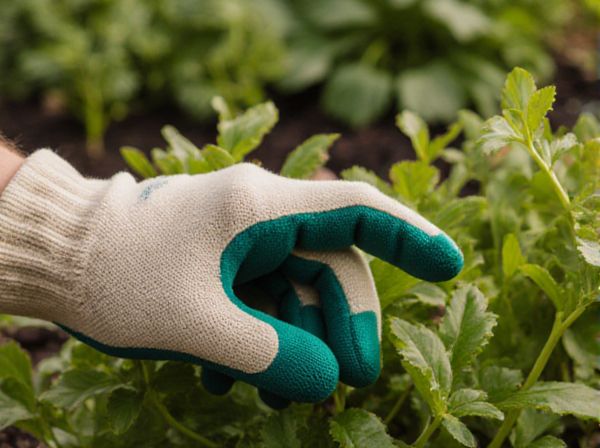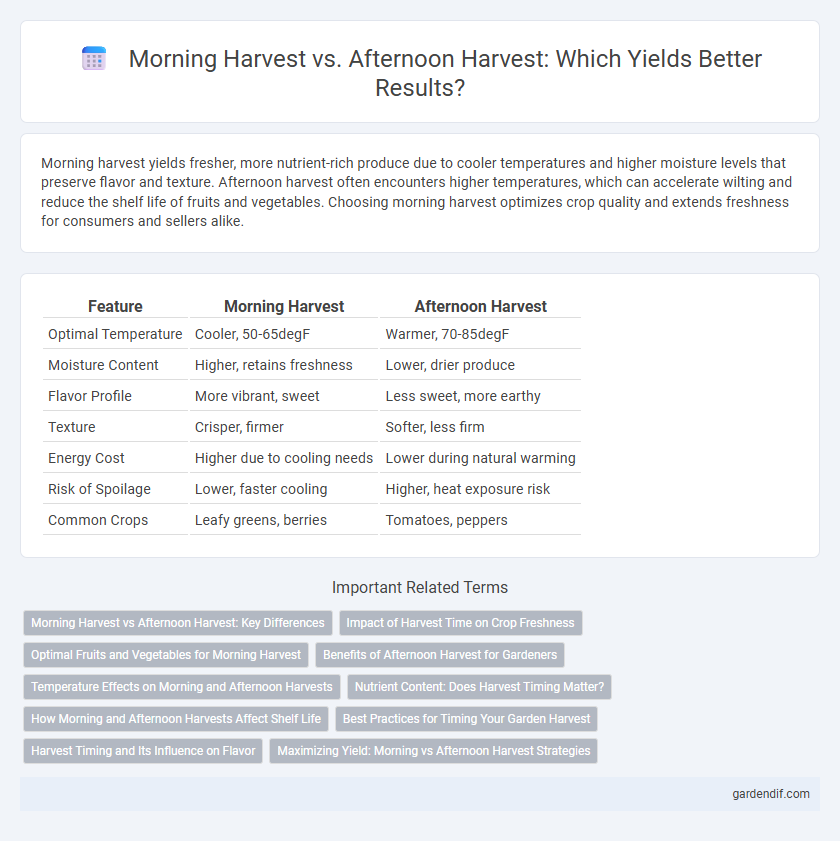
Morning Harvest vs Afternoon Harvest Illustration
Morning harvest yields fresher, more nutrient-rich produce due to cooler temperatures and higher moisture levels that preserve flavor and texture. Afternoon harvest often encounters higher temperatures, which can accelerate wilting and reduce the shelf life of fruits and vegetables. Choosing morning harvest optimizes crop quality and extends freshness for consumers and sellers alike.
Table of Comparison
| Feature | Morning Harvest | Afternoon Harvest |
|---|---|---|
| Optimal Temperature | Cooler, 50-65degF | Warmer, 70-85degF |
| Moisture Content | Higher, retains freshness | Lower, drier produce |
| Flavor Profile | More vibrant, sweet | Less sweet, more earthy |
| Texture | Crisper, firmer | Softer, less firm |
| Energy Cost | Higher due to cooling needs | Lower during natural warming |
| Risk of Spoilage | Lower, faster cooling | Higher, heat exposure risk |
| Common Crops | Leafy greens, berries | Tomatoes, peppers |
Morning Harvest vs Afternoon Harvest: Key Differences
Morning harvest typically captures higher moisture content and fresher nutrient profiles due to cooler temperatures and reduced plant respiration overnight. Afternoon harvest tends to yield crops with lower moisture but potentially higher sugar concentration as plants continue photosynthesis under sunlight. These differences influence post-harvest processing, storage, and overall crop quality optimization strategies.
Impact of Harvest Time on Crop Freshness
Harvesting crops in the morning typically results in higher freshness due to lower temperatures and higher moisture content in the plants, which slows down wilting and nutrient degradation. Afternoon harvests can lead to faster water loss and reduced quality since heat and sunlight accelerate respiration and spoilage. Studies show morning-harvested produce maintains better texture, flavor, and nutritional value compared to afternoon yield.
Optimal Fruits and Vegetables for Morning Harvest
Morning harvest maximizes the nutritional value and freshness of fruits and vegetables such as leafy greens, berries, and herbs, which retain higher levels of antioxidants and moisture when picked early. Cool morning temperatures help reduce plant stress and sugar depletion, preserving flavors and extending shelf life. Farmers prioritize varieties like tomatoes, spinach, and blueberries during morning harvests to ensure peak quality and optimal taste.
Benefits of Afternoon Harvest for Gardeners
Afternoon harvest allows gardeners to collect crops when plants have maximized photosynthesis, resulting in higher sugar content and improved flavor. Warm afternoon temperatures reduce moisture on produce, decreasing the risk of mold and extending shelf life. This timing also encourages sturdier stems and better nutrient retention, enhancing the overall quality and resilience of garden yield.
Temperature Effects on Morning and Afternoon Harvests
Morning harvests benefit from cooler temperatures, which help preserve the freshness, flavor, and nutrient content of crops by reducing stress and moisture loss. In contrast, afternoon harvests face higher temperatures that can accelerate respiration rates in plants, leading to faster degradation and potential quality loss. Optimizing harvest times based on temperature variations enhances post-harvest quality and extends shelf life for delicate produce.
Nutrient Content: Does Harvest Timing Matter?
Morning harvest typically preserves higher nutrient content in fruits and vegetables due to cooler temperatures and reduced exposure to sunlight, which slows nutrient degradation. Afternoon harvest may lead to decreased levels of vitamin C, antioxidants, and essential minerals as heat and sunlight accelerate nutrient loss. Choosing morning harvests can enhance the nutritional value and freshness of produce, supporting better health benefits.
How Morning and Afternoon Harvests Affect Shelf Life
Morning harvests typically yield crops with higher moisture and sugar content, enhancing freshness and extending shelf life due to reduced microbial growth. Afternoon harvests expose produce to increased heat and sunlight, accelerating respiration and enzymatic activity that can shorten shelf life. Optimal harvest timing balances these factors to maintain quality and prolong storage duration.
Best Practices for Timing Your Garden Harvest
Morning harvests often yield higher nutrient content and fresher produce as plants are fully hydrated from overnight water absorption. Afternoon harvesting can result in wilted or less crisp vegetables due to heat stress and moisture loss throughout the day. Best practices recommend collecting fruits and vegetables early in the morning to maximize flavor, shelf life, and nutritional value.
Harvest Timing and Its Influence on Flavor
Morning harvest often captures cooler temperatures that preserve the delicate, bright flavors and higher acidity in fruits and vegetables, enhancing their freshness and crispness. Afternoon harvest, exposed to warmer temperatures and prolonged sunlight, typically results in riper produce with intensified sweetness and deeper flavor profiles. The timing of harvest directly influences the biochemical composition, affecting sugar concentration, acidity levels, and aromatic compounds that define the overall taste experience.
Maximizing Yield: Morning vs Afternoon Harvest Strategies
Harvesting in the morning often maximizes yield by preserving moisture and reducing plant stress, which enhances crop quality and shelf life. Afternoon harvests can lead to increased water loss and wilting due to higher temperatures, negatively impacting weight and market value. Selecting the optimal harvest time based on crop type and local climate conditions ensures improved yield consistency and profitability.
Morning Harvest vs Afternoon Harvest Infographic

 gardendif.com
gardendif.com